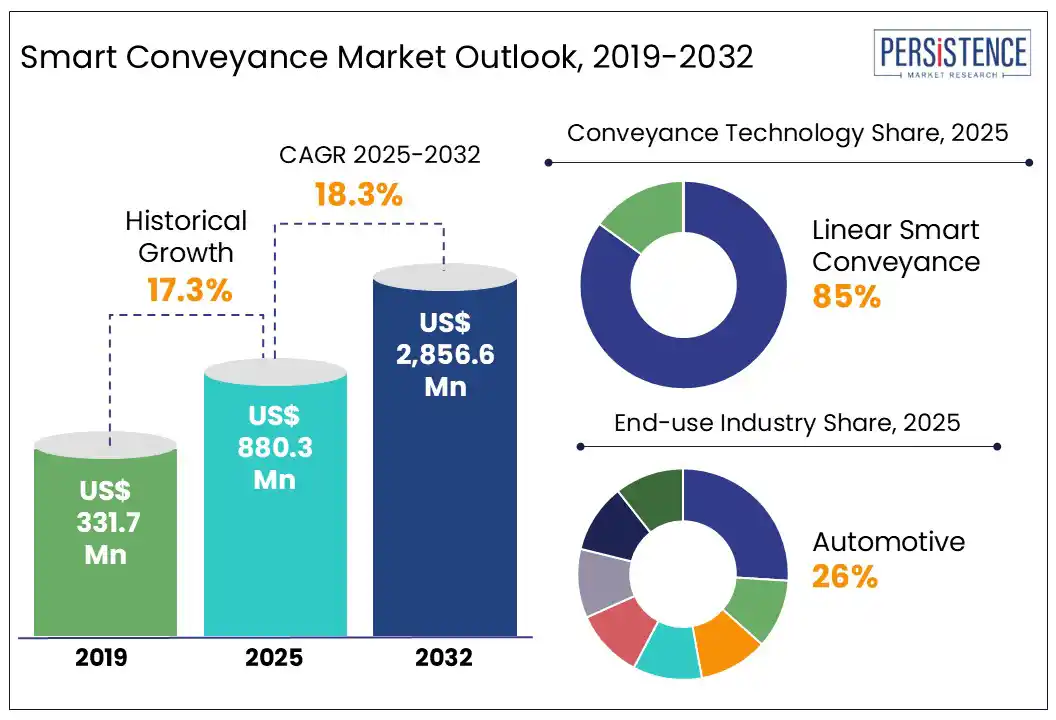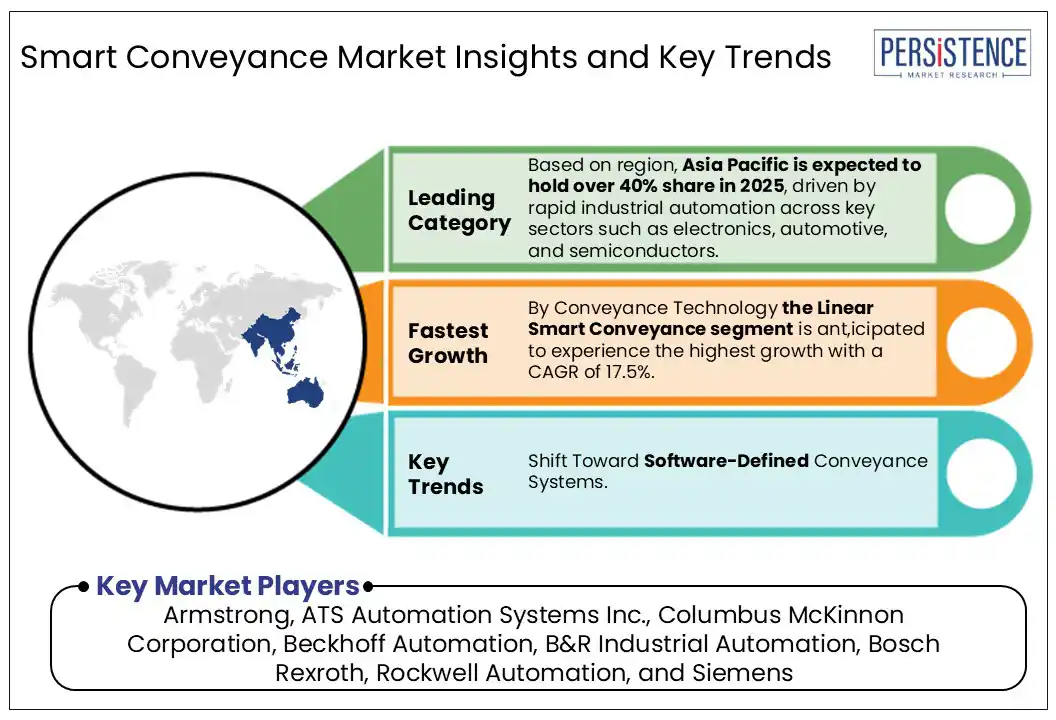ID: PMRREP35485| 188 Pages | 14 Jul 2025 | Format: PDF, Excel, PPT* | Industrial Automation

The global Smart Conveyance market size is likely to be valued at US$ 880.3 Mn in 2025 and is estimated to reach US$ 2,856.6 Mn in 2032, at a CAGR of 18.3% during the forecast period 2025 - 2032.
Smart conveyance solutions are advanced material handling systems that use smart sensors and motion control technologies to move parts intelligently and flexibly within manufacturing processes. They are increasingly adopted by industries prioritizing throughput, adaptability, and digitization. The smart conveyance market growth is fueled by advancements in software-defined motion control, modular platform designs, adoption across high-precision sectors, and the emphasis on smart factories.
In smart conveyance, each shuttle moves on its own to reach a specific destination. This flexibility enables more efficient and adaptable workflows unlike traditional conveyor belts, which fixedly move items. These systems enable real-time tracking, collision avoidance, and predictive maintenance. Beckhoff and Rockwell Automation dominate the market, and manufacturers such as Bosch Rexroth and Schneider Electric are entering with their products.

Key Industry Highlights:
|
Global Market Attribute |
Key Insights |
|
Smart Conveyance Market Size (2025E) |
US$ 880.3 Mn |
|
Market Value Forecast (2032F) |
US$ 2,856.6 Mn |
|
Projected Growth (CAGR 2025 to 2032) |
18.3% |
|
Historical Market Growth (CAGR 2019 to 2024) |
17.3% |
One of the primary driving factors for the smart conveyance market is the widespread adoption of Industry 4.0 across global manufacturing sectors. As factories transition toward digitalization, there is a growing need for intelligent material handling systems that integrate seamlessly with advanced technologies such as the Industrial Internet of Things (IIoT), AI, machine learning, and cloud computing. Smart conveyance systems fulfill this need by offering programmable motion control, embedded sensors, and real-time performance monitoring, enabling predictive maintenance, self-diagnosis, and adaptive material flow. This results in reduced downtime, higher throughput, and improved operational efficiency.
Major industrial players such as Siemens and Rockwell Automation are actively deploying modular conveyors equipped with these features, highlighting their critical role in modern production environments. In automotive and electronics manufacturing, where rapid product changes are frequent, smart conveyors enable swift changeovers and mass customization.
Countries including Germany and Japan are leading this transformation, leveraging smart conveyance as part of broader efforts to build lean, agile, and connected factories. Furthermore, the integration of human talent with intelligent machines enhances productivity by automating repetitive tasks, allowing workers to focus on innovation and problem-solving. As Industry 4.0 initiatives continue to scale, the demand for smart conveyance systems is expected to surge across diverse industries.
A key restraint limiting the widespread adoption of smart conveyance systems is their high upfront cost, especially for small and medium-sized enterprises (SMEs). These systems typically require advanced components such as linear motors, sensors, and control platforms that can cost 50–70% more than traditional conveyors. In emerging markets, where automation budgets are often constrained, the return on investment may not be justifiable in the short term. Additionally, integrating these systems into legacy production lines poses significant technical challenges.
Older equipment may not support modern protocols such as Open Platform Communications Unified Architecture (OPC-UA) or Message Queuing Telemetry Transport (MQTT), necessitating custom coding, extended training, and operational downtime. This complexity deters firms with limited automation expertise. Cybersecurity concerns further compound these issues. As smart conveyance becomes more connected, the risk of cyberattacks increases. A 2023 breach in South Korea highlighted this risk, with system downtime causing production losses. For industries handling sensitive data, such vulnerabilities remain a significant adoption barrier.
Smart conveyance solution providers have a significant opportunity to capitalize on the growing demand for adaptable and scalable systems across industries such as electronics, pharmaceuticals, and packaging. Market players are embracing “Customization-as-a-Service” by offering modular, software-defined conveyance platforms that are easy to configure, scale, and reprogram. Companies, such as Beckhoff and Bosch Rexroth, are leading the way with plug-and-play systems that reduce downtime and enable seamless adaptation to frequent product or layout changes.
Siemens’ alliance with SuperTrak CONVEYANCE™, integrating the Horizon3™ platform with the TIA Portal, further illustrates how customized, synchronized automation can boost throughput, streamline engineering, and support compact factory designs.
Leading innovations such as Beckhoff’s XTS (eXtended Transport System) and B&R’s ACOPOStrak are gaining adoption in packaging, semiconductor, and pharmaceutical manufacturing, where precision and customization are critical. These intelligent systems also integrate easily with IoT platforms, enhancing real-time monitoring, diagnostics, and predictive maintenance.
The linear smart conveyance technology segment is projected to dominate the global smart conveyance market, accounting for over 85% of the total market share over the forecast period. This overwhelming lead is primarily attributed to its superior precision, flexibility, and speed in handling complex motion profiles across various industrial applications. Unlike traditional mechanical systems, linear smart conveyance systems use advanced servo motors and intelligent software to enable independent control of shuttles, allowing for highly customized and synchronized movements.
This technology is valuable in high-mix, low-volume manufacturing environments such as electronics, pharmaceuticals, automotive components, and packaging, where rapid changeovers, minimal downtime, and scalable production are essential. Moreover, linear systems support Industry 4.0 objectives by integrating seamlessly with sensors, PLCs, and MES platforms, enabling real-time monitoring, predictive maintenance, and optimized throughput.
Leading manufacturers such as Rockwell Automation (iTRAK), Beckhoff (XTS), and B&R Industrial Automation (ACOPOStrak) are heavily invested in expanding their linear smart conveyance portfolios to meet the growing demand for modular, compact, and reconfigurable systems. As a result, the segment continues to attract widespread adoption due to its ability to deliver higher productivity, reduce mechanical complexity, and support agile manufacturing, a trend expected to persist as industries continue shifting toward smart, digitized production system.
The automotive industry is expected to hold over 26% share in 2025. This stronghold is driven by the sector’s advanced adoption of Industry 4.0 practices, where smart conveyors are integral to high-speed, precision-oriented automotive production lines. These systems support just-in-time (JIT) and just-in-sequence (JIS) manufacturing strategies, ensuring efficient movement of complex assemblies such as engines, battery modules, and electronic components.
With features such as modularity, real-time data tracking, and predictive maintenance, smart conveyors help reduce downtime, optimize labor, and boost productivity. The rising focus on electric vehicle (EV) production has further accelerated the demand for intelligent and flexible material handling solutions within automotive plants, reinforcing the industry's dominant market share.
In contrast, the retail and e-commerce industry segment is emerging as the fast-growing in the smart conveyor market, propelled by the global boom in online shopping and fulfillment logistics. Warehouses and distribution centers are increasingly deploying smart conveyor systems to automate high-volume order sorting, enable real-time inventory tracking, and integrate with robotic picking and packing systems.

Asia Pacific is projected to lead the global smart conveyance market, accounting for over 40% of the total market share in 2025. This growth is fueled by the region's rapid industrial automation across key sectors such as electronics, automotive, and semiconductors.
China remains at the forefront, driven by large-scale investments in smart manufacturing under initiatives such as Made in China 2025, which prioritize modular, automated, and intelligent production systems. In 2023, China’s manufacturing reached US$4.66 Tn, representing 29% of the global total, more than the combined output of the next four largest manufacturing nations (the U.S., Japan, Germany, and India). This immense manufacturing capacity provides a robust foundation for the widespread deployment of smart conveyance systems, especially in high-speed, precision-driven production environments.
In Japan and South Korea, advanced integration of robotics, AI, and IoT in industrial operations is accelerating the shift toward intelligent conveyor solutions with adaptive motion control. Meanwhile, India is experiencing rapid adoption, driven by the “Make in India” initiative, infrastructure upgrades, and growing demand for automated logistics. Across East Asia, the booming battery and semiconductor industries are further amplifying the demand for high-performance, digitally controlled conveyance systems.
North America remains the second-largest smart conveyance (market globally and is poised for robust growth), and is projected to register a CAGR of 17.1% by the end of 2032. Particularly the U.S., holds a dominant position in the global smart conveyance market, driven by a mature e-commerce ecosystem, rapid warehouse automation, and strong industrial output.
In 2024, the North American warehousing and storage market reached a valuation of US$ 86.5 Bn, up from US$ 72 Bn in 2018, underscoring the region’s sustained investment in logistics infrastructure. Major players including Amazon, FedEx, and Walmart are leading the deployment of smart conveyor systems integrated with AI, machine learning, and robotic automation to streamline real-time order processing and fulfillment.
According to the National Metrology Institute and BEA, manufacturing contributed US$ 2.3 Tn to the U.S. GDP in 2023, amounting to 10.2% of the total GDP and 17.1% when including indirect contributions. Employment in the manufacturing sector reached 15.6 million, representing 9.7% of the total U.S. workforce.
In parallel, the rise of B2B eCommerce is reinforcing automation demand. According to the International Trade Administration (ITA), the global B2B eCommerce market is expected to reach US$ 36 Tn by 2026, driven largely by heavy industries such as advanced manufacturing, energy, healthcare, and professional services. This growth is prompting increased adoption of precision motion smart conveyors and IoT-enabled systems in North America, particularly in sectors such as automotive, aerospace, and electronics. Government incentives supporting industrial digitalization further accelerate smart conveyance deployment across the region.
The competitive landscape in the global smart conveyance technology market is marked by intense innovation and strategic differentiation. Rockwell Automation leads with its iTRAK and MagneMotion systems, offering scalable and high-speed solutions integrated with advanced control platforms. Beckhoff Automation is strengthening its position with the XTS system, targeting industries such as food and pharmaceuticals that demand flexibility and hygienic design.
B&R Industrial Automation (ABB) competes through its ACOPOStrak system, known for independent shuttle control and zero-changeover capabilities, ideal for high-mix, fast-paced production lines. Niche players such as ASI Technologies and Electroimpact are gaining ground by delivering customized solutions for aerospace and electronics. Overall, the market remains highly competitive, with players focusing on AI integration, IIoT connectivity, and real-time analytics to stand out. In December 2024, Siemens and SuperTrak CONVEYANCE™ announced a strategic collaboration to integrate SuperTrak’s Horizon3™ platform into Siemens’ TIA Portal and SIMATIC S7?1500T controller system.
The global smart conveyance market is estimated to be valued at us$ 880.3 mn in 2025.
Industry 4.0 adoption is a key driver, with smart conveyance systems enabling AI-integrated, sensor-enabled, and predictive maintenance-based automation.
The Linear Smart Conveyance is the fast-growing segment at a positive CAGR from 2025 to 2032.
The Smart Conveyance market is poised to witness a CAGR of 18.3% between 2025 and 2032.
Armstrong, ATS Automation Systems Inc., Columbus McKinnon Corporation, Beckhoff Automation, B&R Industrial Automation, Bosch Rexroth, Rockwell Automation, Siemens are some key industry players in the Global Smart Conveyance market.
|
Report Attribute |
Details |
|
Historical Data/Actuals |
2019 - 2024 |
|
Forecast Period |
2025 - 2032 |
|
Market Analysis Units |
Value: US$ Mn |
|
Geographical Coverage |
|
|
Segmental Coverage |
|
|
Competitive Analysis |
|
|
Report Highlights |
|
|
Customization and Pricing |
Available upon request |
By Component
By Conveyance Type
By Industry
By Load Capacity
By Conveyance Technology
By Region
Delivery Timelines
For more information on this report and its delivery timelines please get in touch with our sales team.
About Author